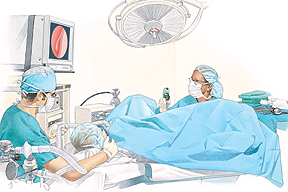Hysteroscopy
Hysteroscopy is a procedure that allows your healthcare provider to see inside your uterus. Diagnostic hysteroscopy can help find the causes of problems in the uterus. This helps determine the best treatment. In some cases, operative hysteroscopy is used to treat problems. The procedure may be done in a doctor's office, hospital, or same day surgery center.

Reasons for the Procedure
Hysteroscopy may be done based on the results of other tests. It's often performed to find out what's causing problems, including:
What Are the Risks?
Complications of hysteroscopy are fairly rare. They may include:
-
Infection or bleeding
-
Perforation (tearing) of the uterine wall
-
Damage to internal organs
-
Scarring of the uterus
-
Problems with anesthesia (the medication that prevents pain during the procedure)
Preparing for the Procedure
Tell your healthcare provider if you have any health conditions such as diabetes, heart disease, or bleeding problems. Also tell your healthcare provider about all the medications you take. This includes any over-the-counter products, herbs, or supplements. Before the procedure, you may be tested for pregnancy and infection. You may also be asked to sign a consent form.
Special Instructions
Based on the type of hysteroscopy you're having, you will be given instructions on how to prepare. For a few days before the procedure you'll likely have to avoid creams or other vaginal medications, sexual intercourse, and douching. Ask your doctor if you should:
-
Not eat or drink anything after the midnight before the procedure.
-
Take an over-the-counter pain reliever an hour before the procedure, to help relieve cramping that may occur.
During Hysteroscopy
-
You will lie on an exam table with your knees bent, as you do for a pelvic exam.
-
An instrument called a speculum is inserted into the vagina to hold it open. Another instrument called a dilator may be used to widen the cervix.
-
Your cervix may be numbed with a local anesthetic. Medications may also be given to help you relax or sleep. You may receive medications and fluids through an IV.
-
The hysteroscope (a long, thin telescope) is inserted through the vagina and into the uterus. This is used to see inside the uterus. Images of the uterus may also be shown on a monitor.
-
A harmless gas or fluid may be injected into the uterus to expand it.
-
Surgical instruments may be inserted through the hysteroscope to take tissue samples or remove growths.
After the Procedure
-
You may have menstrual-like cramps and bleeding for about 24 hours after the procedure. This is normal. Use pads instead of tampons.
-
Don't douche, use any vaginal medications, or use tampons until your healthcare provider tells you it's okay.
-
Ask your healthcare provider when it's okay to have sex again.
Call Your Healthcare Provider If You Have:
Follow-Up
Within a few days, your healthcare provider will let you know the results of your hysteroscopy. This may be done over the phone or at a follow-up visit. Based on what was found during the procedure, you may need further treatment. Follow your healthcare provider's instructions and keep any appointments that are scheduled.







